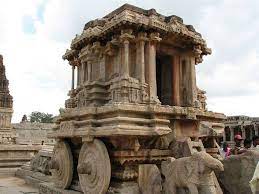Hampi Stone Chariot UPSC | Why In The News ?
- The Archaeological Survey of India (ASI) has put up a chain barricade to prevent people from touching or climbing the iconic stone chariot in front of the Vijaya Vittala Temple at Hampi and causing damage to it in any way.

About Hampi stone chariot :
- The chariot was built by King Krishnadevaraya of the Vijayanagara Empire during the 16th
- The chariot is a shrine dedicated to Garuda, built inside the Vittala Temple Complex.
- The massive sculpture of Garuda, Lord Vishnu’s escort once was seated atop the chariot but it is empty at the present date.
The Hampi chariot is one among the three famous stone chariots in India, the other two being in
- Konark, Odisha
- Mahabalipuram, Tamil Nadu.
World Heritage Status :
- It is internationally recognized as a world heritage site by UNESCO.
Architectural Features of the Chariot
- It is inspired by the Dravidian style of architecture.
- The chariot looks like one solid structure but in fact, has been built by slabs of granite.
- The base on which the chariot rests depicts beautiful mythical battle scenes in intricate details.
- There were sculptures of horses where presently elephants are seated.
Read Also – Buddhist Councils UPSC | First | Second | Third & Fourth Councils
About Hampi:
- It was the last capital of the last great Hindu Kingdom of Vijayanagar.
- It was a part of the Mauryan Empire back in the third century BC.
- It is a UNESCO World Heritage site.
- Its name is derived from Pampa which is the old name of the Tungabhadra River on whose banks the city is built.
- The site used to be multi-religious and multi-ethnic; it included Hindu and Jain monuments next to each other.
Vijayanagara Empire :
- Vijayanagara or “city of victory” was the name of both a city and an empire.
- The empire was founded in the fourteenth century (1336 AD) by Harihara and Bukka of the Sangama dynasty.
- It stretched from the river Krishna in the north to the extreme south of the peninsula.
Vijayanagar Empire was ruled by four important dynasties and they are:
- Sangama
- Saluva
- Tuluva
- Aravidu
About Dravidian Style Architecture :
- The dravida temple is enclosed within a compound wall.
- The front wall has an entrance gateway in its centre, which is known as Gopura/ Gopuram.
- The shape of the main temple tower is known as Vimana (shikhara in nagara style).
- The vimana is like a stepped pyramid that rise up geometrically rather than the curving shikhara of north India.
- In south India, the word Shikhara is used only for the crowning element at the top of the temple which is usually shaped like a small stupika or an octagonal cupola (this is equivalent to the amalaka or kalasha of north Indian temples).
- In north Indian temples we can see images such as Mithunas (erotic) and the river goddesses, Ganga and Yamuna guarding the temple.
- But in the Dravida style of temple architecture, instead of these sculptures, we can see the sculptures of fierce dvarapalas or door keepers guarding the temple.
- A large water reservoir or a temple tank enclosed in the complex is general in south Indian temples.
- Subsidiary shrines are either incorporated within the main temple tower, or located as a distinct, separate small shrine besides the main temple.
- The north Indian idea of multiple shikharas rising together as a cluster was not popular in dravida style.
- When the population and the size of the town associated with the temple increased, it would have become necessary to make a new boundary wall around the temple (and also associated structures).
- An example for this is the Srirangam temple at Thiruchirapally, which has as many as seven concentric rectangular enclosure walls, each with gopurams.
- The outermost is the newest while the tower right in the centre housing the garbhagriha is the oldest.
Just as the nagara architecture has subdivisions, dravida temples also have subdivisions. These are basically of five different shapes:
- Kuta or caturasra – square.
- Shala or ayatasra – rectangular.
- Gaja-prishta or vrittayata (elephant backed) –elliptic
- Vritta – circular
- Ashtasra – octagonal
Source – TH







